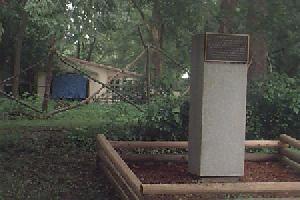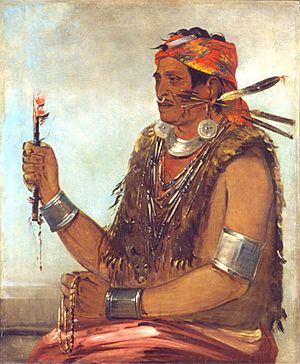White Feather Spring facts for kids
Quick facts for kids |
|
|
Whitefeather Spring
|
|

The marker at Whitefeather Spring. The spring itself is off to the left down a small hillside.
|
|
| Location | 3818 Ruby Avenue, Kansas City, Kansas |
|---|---|
| NRHP reference No. | 75000728 |
| Added to NRHP | August 27, 1975 |
The Whitefeather Spring is a special natural spring located in the Argentine area of Kansas City, Kansas. It's on private land. The spring is named after Susan White Feather, who was the first person to own this land after a big land agreement called the Treaty of 1854.
History
In 1826, a Native American leader named Tenskwatawa started a village. This village was in what is now Kansas City, Kansas. Tenskwatawa was known as the Shawnee Prophet. He was the younger brother of Tecumseh, a famous Shawnee war chief.
Tenskwatawa first built a village called Prophetstown. It was near where South 26th Street and Woodend Avenue are today. Later, he moved his home to the Whitefeather Spring area. He passed away here in November 1836. The Whitefeather Spring marker shows where his home was located.
Finding the Prophet's Grave
The Prophet's grave was about 75 to 100 yards northwest of his home. For about 60 years, it did not have a marker. In 1897, a newspaper editor named E. F. Heisler wanted to find it.

Heisler traveled to the Indian Territory. He found Charles Bluejacket. Bluejacket had been present at the Prophet's burial when he was 20 years old. Bluejacket helped them find the natural spring. This spring still flows today, and it was where the Prophet's home used to be.
Bluejacket then told everyone where the Prophet's grave was. A temporary marker was placed there. However, this marker was later removed. No permanent marker was ever put down. Because of this, the exact location of the Prophet's grave is not known today.



